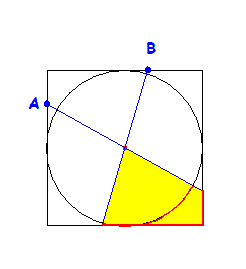-
Posts
871 -
Joined
-
Last visited
-
Days Won
7
Content Type
Profiles
Forums
Events
Gallery
Blogs
Everything posted by Prime
-
This game is played at a bar sometimes. (By those patrons who lost all hope of picking up a date.) Coins are arranged in 3 rows as following: First row -- 3 coins; Second row -- 5 coins; Third row -- 7 coins. Two players take turns to make their move. On your turn you must take any number of coins (more than zero) from one and only one row. Player who takes the last coin -- loses, and must buy the winner a drink. I. Find the strategy forcing your win, if you move first. II. For N rows (N >= 2), any number of coins in each row, find the formula for the winning strategy. Or, to put it differently, find the formula for the winning (or losing) position on your move.
-
Do you want to make it a new topic? I mean, you are the original designer of those robots. And you can formulate a problem so much better. On a related note. We do need an "unsolved problems" category on this forum.
-
I think you misinterpret the point that I was making. And, I believe, including or excluding cases with two diametrically opposite points from center-capturing does bear on the oucome of the experiment. Even though it gets burried under normal deviation. Change your randomizer to give only 8 possible points (from 0 to 7). And run the simulation again. Or, to convince yourself without experiment, imagine your randomizer gave only two possible values: 0 and 1/2, which represent diametrically opposite points on the perimeter. All you've said is that the correct answer for a specific case is not the correct answer for the OP. You have omitted my assertion that all those individual cases are uniformly distributed. (Each is as likely as another.) And the overall probability is the average of their probabilities. The only way I can construct a reasoning for (1/2)*(1/2) solution is as following: It is interesting -- the difference in our approaches to solving problems. My way tends toward sequential processing. Yours is more like parallel.
-
So zero it is. On to openning the ends of the rail and calculating average distance (time) before the robot falls off?
-
edit:grammar Seems you made a typo in the end. You meant your end result to be 473(four of a kind) + 24(SF) = 497 hands beat aces full of nines. (Instead of 431+24=455).
-
I like Alex. He is a hustler. Are there Jokers in the deck by chance?
-
I wasn't so much criticizing the experiment as the means for veryfying theoretical results, as pointing out an interesting difference between theoretical probability and the experiment design. Even though I was wrong attributing deviation to that difference, still... Suppose random number generator produces numbers with 10 significant (decimal) digits. For a total number of points 1010. The ratio of number of pairs of diametrally opposite points to total number of pairs is 10-10, thus affecting the experiment results ever so slightly. In case of mathematical zero-dimension points that ratio is zero. Therefore, it does not matter, in theory whether to include center capture into diameter cases, or not. That said, I disagree with multiplying probilities of points being on opposite side of center lines: (1/2)*(1/2) as a way of solving this problem.
-
If the question was, what's the total distance traveled by Prime. Then Prof. T. definitely answered that -- 1 mile in one hour. (For Prime robot never rested.) If the net distance was a vector (South -- negative, North -- positive), then as Rossbeemer stated several times, the average would be zero. (There is nothing in the OP to give preference to North or South direction.) Bonanova, purposefully avoided clarifying NET distance -- he expects us to know. Since Bonanova acknowledged neither Prof. T.'s nor Rossbeemer's answers, the NET must be always positive by definition. Given that, I expect the average net distance (displacement off center) to be different from zero. Because at the very least, the initial direction in which Prime moved must account for something.
-
I think "This statement cannot be proven" does not lead to the same kind of paradox as "This statement is false". If we interpret "proof" as a proof of truthfulness (not proof of falsehood), then the statement may be interpreted as asserting impossibility of proof with respect to itself. Which looks plausible, as long as it cannot be proven.
-
As usually, I was not paying due attention when reading the OP. So unlike the first problem, here robots do not fall off the rail. The second paragraph seems to contradict the first. If they all were placed at random, how come Prime is at the midpoint? I suspect, Prime was intentionally set in the middle, and 12 robots on either side of him were placed randomly thereafter. In veiw of that, the question about net distance is whether it means displacement from the origin (midpoint) or total distance traveled.
-
For a million samples, the deviation of +0.02% from the theoretical seems a bit large. I have a theory ...
-
Net distance needs clarification. Is it the distance from Prime's initial position to the edge of the rail at which he exited? Or is it the total distance Prime walked back and forth before falling off?
-
It is different. And, at the first glance, looks much harder.
-
My estimate of probability is 1/4 for the center to fall inside such inscribed triangle. No matter what regular poligon, or circle has 3 random points on its perimeter.
-
It is a good puzzle (sortie). As usually the case, with the initial design, there are some details that need additional work. I think the puzzle would make more sense if KIRA was the perpetrator of crime. Cadet’s apparent lying is not a proof that he/she stole the car. More importantly, there is nothing definite in the statement of the puzzle to exclude KIRA. So, if he/she could be the one, why is it an incorrect solution? And there is nothing that could lead to a conclusion that cadet’s name is KIRA. The only statement in the puzzle that allowed implicating KIRA was cadet’s own assertion that it was one of the people in the houses, which I accepted as a necessary condition. Otherwise, it could have been someone not even mentioned in the puzzle. The fourth person appeared out of nowhere, and I can’t tell whether one of the interrogated suspects was cadet him/herself. So to sum up: If it was not KIRA, there must be something in the statement, that would contradict such conclusion. For it to be a cadet, there must be something in the statement that would force such conclusion. (His lying to superintendent and taking a shortcut to the station are not reasons enough.)
-
I don't think the type of figure matters.
-
It is kind of obvious that you cannot break a square into 2 non-overlaping. But if we must prove it...
-
So I had the same result with respect to true statements. Relying on the condition that it "had to be one of those 4", by elimination KIRA is the only possibility. Of course, Cadet getting there in 15 min by car along freeway and back by foot in 45 min is a bit strange, but not impossible. I don't see how cadet's name could be KIRA. Also "car reported stolen" is a bit ambiguous. It was cadet who actually "reported" it stolen and that took place sometime around 12:15. Another questionable thing is that BILL was with DAN and DAN was with JON, meaning all three of them were together, whereas cadet saw only 2 people in the window of one of the houses.
-
And as I took a second look into my code, I found a bug. It should be: Do While rlen >= 0 instead of Do While rlen >=3. I rerun for 12 tosses only
-
Here is a complete table of precedence for 17 tosses. (In case anyone cares.) As I and HoustonHokie noticed earlier, each triplet occurs exact same number of times as any other. As we already figured out "0" and "7" (HHH and TTT) suffered most in terms of precedence. Whereas, "3" and "4" (HTT and THH) are most likely to appear before any other triplet.
-
I suggest the following nomenclature: 0=Heads 1=Tails Since a triplet is represented by a 3-digit binary number, we could use octal system instead. I.e., 000=0, 001=1, 010=2, ... , 111=7. Consider two immediately neighboring triplets (4 tosses)... CR already noted the dependency. So an example of triplets with less chance of appearing before others are "000" and "111". However, others may also not have the same probability of "precedence". So are we looking for the exact probability of precedence in 17 tosses for each triplet?
-
That was my point precisely. I did say that all triplets are equally likely. And I pointed out the variation of "0000", stating that the trailing "000" lost its opportunity to have an immediate predecessor other than itself. I understood, Bn asked whether some triplets are more likely to appear before others. And "011" is more likely to appear before "000" in 4 consecutive tosses.
-
Actually, I should take it back. "Cannot be proved" is not the same as "This statement is false".
-
Same has been posted just recently. With a number of other variations before. (See "Crocodile Sophism").


